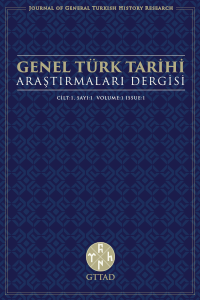THE APPEARANCE AND FORMATION OF THE ANCIENT TURKIC WRITTEN LANGUAGE
Ancient Turkic Language, Runic, Phonogram, morfogram, Logogram
THE APPEARANCE AND FORMATION OF THE ANCIENT TURKIC WRITTEN LANGUAGE
Ancient turkic language, , fonogram, formogram,
___
- 1. Batsaıhan Z. Sıunnugıın «kemu» bıchıg, tuunıı holbogdol. // SA.T.XIV. UB.1994.108-115 p. 2. Bıchurın N.Ia. (Iaknıf). Sobranıe svedenıı o narodah, obıtavshıh v Sredneı Azıı v drevnıe vremena. М-Л.1950.т.І. 3. Damdınsúren A. Arheologıın shınjılgeegeer oldson hunnugıın bıchgıın dursgaluud. // SA.T.V.fasc.1-13. UB.1972.99-111 тал. 4. Huang bo rong.Xian dai han yu, Beijing.2004.163 5. Istrin V.А. Vozniknovenie i razvitie pis’ma. М.1965. 6. Jungo tarıhnamalaryndaǵy qazaqqa qatysty derekter. t.II. Pekın.2003. 7. Kyzlasov I.L. Runıcheskıe pısmennostı Evrazııskıh stepeı. М.1994. 8. Lıvshıts V.A. O proıshojdenıı drevneturkskoı runıcheskoı pısmennostı // Arheologıcheskıe ıssledovanııa drevnogo ı srednevekovogo Kazahstana.А-А.1980.с.3-13. 9. Mongolyn arheologı. UB.2002. 10. Nemeth J. Die inscriften des Schatzcs von Nage-Szent-Miklos. Leipzig.1932. 11. Novogradova E.A. V strane petroglıfov ı edelveısov. М.1982. 12. Novogradova E.A. Arashan-had – drevneıshıı pamıatnık ızobrazıtelnogo ıskusstva Vostochnyı Mongolıı. // Istorııa ı kultury Tsentralnoı Azıı. М.1983.p.303-310. 13. Okladnıkov A.P. Tsentralnoazıatskıı ochag pervobytnogo ıskusstva. Novosıbırsk.1972. 14. Qazaq tіlі grammatıkasy. А.2002. 15. Sartqoja Q. Baıyrgy turіk jazuynyn genezısі. Astana. 2003. 16. Sartqojauly Q. Altaıdan tabylǵan ejelgі túrіk jazuu // Uluslararasi Turkoloji kongresi. Turkstan.2009. c.137-145. 17. Sherbak A.M. Turkskaıa runıka. St-B.2001. 18. Sherbak A.M. Neskolko slov o prıemah chtenııa runıcheskıh nadpıseı, naıdennyh na Donu // СА. 1954.p.269-282. 19. Sherbak A.M. O runıcheskoı pısmennostı v yugo-vostochnoı Evrope // СТ. 1971.№4.p.76-82. 20. Zhonggou gudai huo bi fa zhan shi, Beijing. 1958, 71-72
- Yayın Aralığı: 2
- Başlangıç: 2019
- Yayıncı: Özgür Türker
XVII. VE XVIII. YÜZYIL OSMANLI DEVLETİNDE ANKARA MAHALLELERİ
GÖKTÜRKLER VE ÜZENGİNİN YAYILMASI ÜZERİNE
Farhad MAKSUD, Rahmanali MURADALİYEV
“RADLOFF: 50 SENELİK BİR HİZMET-İ İLMÎYE
SADRİ MAKSUDÎ ARSAL, EMRE ÖZSOY
17. VE 18. YÜZYIL OSMANLI DEVLETİ'NDE ANKARA MAHALLELERİ
KIRIM’DA ALMAN İŞGALİ VE OSMANLI DEVLETİ’NİN TUTUMU ÜZERİNE BİR DEĞERLENDİRME (1918)
“TEGİN” UNVANLI BATI TÜRKİSTAN YÖNETİCİLERİ HANGİ SOYDAN İDİLER?
